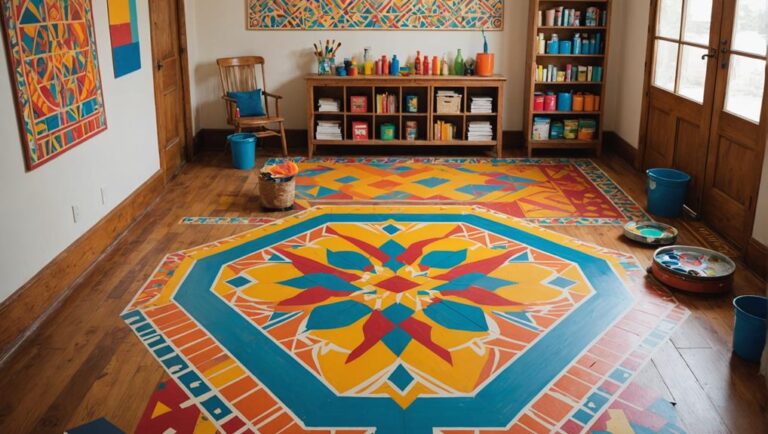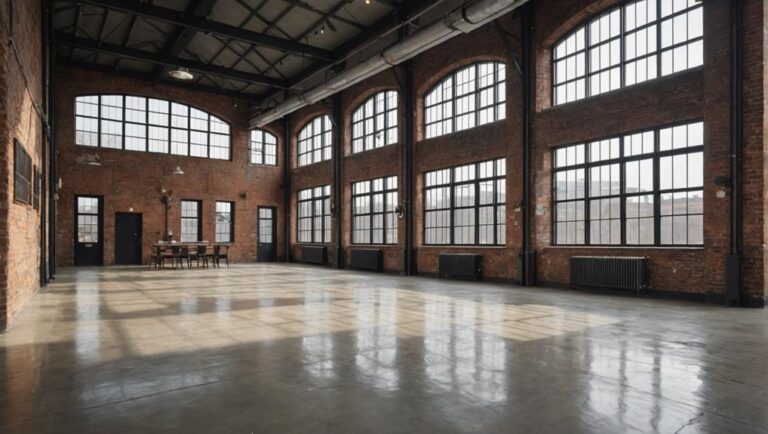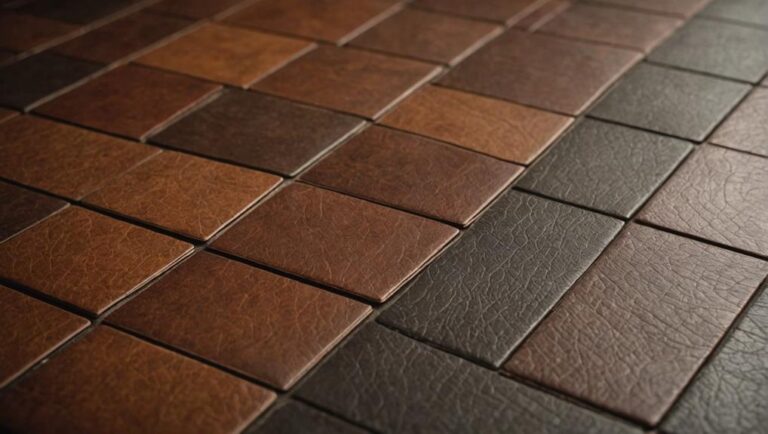Choosing stain-resistant flooring for your rental can elevate both aesthetics and functionality. Consider options like luxury vinyl, which mimics natural materials while being waterproof and easy to clean, or cozy carpet tiles that offer comfort and easy replacement. Laminate is also a stylish choice with good stain resistance but may need extra care. Prioritize durability and slip resistance, especially for high-traffic areas, to guarantee tenant satisfaction and safety. With proper maintenance, these materials can create a welcoming environment that lasts. Discover how to make the most of your flooring decision and enhance your rental's appeal.
Importance of Stain-Resistant Flooring
When it comes to choosing flooring, the importance of stain-resistant materials can't be overstated. You want a surface that not only enhances the aesthetic appeal of your rental space but also stands up to the everyday challenges of living. Stain prevention is vital, especially in high-traffic areas where spills and accidents are a part of life. By opting for stain-resistant flooring, you're investing in a solution that offers both beauty and practicality.
Imagine a vibrant, welcoming living room. The colors pop, and the design feels inviting. Now picture it marred by unsightly stains from food or drink spills. Stain-resistant flooring helps eliminate that worry, allowing you to maintain a pristine environment that reflects your commitment to quality. It's not just about looks; it's about ensuring tenant satisfaction. A clean, well-maintained space can greatly impact how tenants feel about their home and their willingness to stay long-term.
Moreover, stain-resistant materials contribute to safety. They often come with non-slip surfaces, reducing the risk of accidents from spills. This is especially important in homes with children or elderly residents. By prioritizing stain-resistant flooring, you're creating a safer and more enjoyable living space. You're not just protecting your investment; you're enhancing the overall experience for your tenants. Ultimately, stain-resistant flooring is a smart choice that balances functionality with aesthetic appeal, ensuring a space that's both beautiful and practical for everyone who walks through the door.
Popular Stain-Resistant Flooring Options
With a diverse range of materials available, selecting the right stain-resistant flooring for your space can be both exciting and overwhelming. You want something that not only looks great but also withstands the daily wear and tear of a rental environment. Here are some popular options to evaluate:
- Luxury Vinyl: This durable flooring mimics the appearance of natural wood or stone while offering exceptional stain resistance. It's waterproof, making it a safe choice for kitchens and bathrooms. Plus, the cushioning underfoot provides comfort, reducing the risk of slips and falls.
- Carpet Tiles: These versatile tiles are perfect for creating a cozy atmosphere while being easy to maintain. If a spill occurs, you can simply replace the affected tile rather than the entire floor. Many carpet tiles are made from stain-resistant fibers, ensuring longevity and safety for your family or guests.
- Laminate Flooring: Though not mentioned above, it's worth noting that laminate flooring can also be a smart stain-resistant choice, providing a sleek finish, ease of cleaning, and a variety of styles.
When choosing the right flooring, think about your lifestyle and how well the material will hold up against stains and spills. Each of these options offers a blend of aesthetic appeal and functional safety, so you can enjoy your rental space without the stress of potential damage. Ultimately, the right flooring can transform your home while keeping it safe and stylish.
Pros and Cons of Each Material
As you navigate the world of stain-resistant flooring options, understanding the pros and cons of each material can help you make an informed decision. Carpet tiles are a popular choice, offering flexibility and ease of installation. They're great for rental spaces, as you can replace individual tiles if they get stained or damaged. Plus, the cushioning provides comfort and a warm feel underfoot. However, carpet tiles can absorb spills if not treated properly, so regular maintenance is essential to keep them looking fresh.
On the other hand, luxury vinyl flooring is a standout for its durability and water resistance. It mimics the look of hardwood or stone while being notably easier to clean. This makes it an excellent choice for high-traffic areas in your rental. Luxury vinyl also resists scratches and dents, ensuring it maintains its beauty over time. However, it can be slippery when wet, so you might want to think about adding rugs or mats in areas prone to moisture.
Ultimately, both options have unique advantages and drawbacks. Carpet tiles offer comfort and easy replacement, while luxury vinyl excels in durability and maintenance. By weighing these pros and cons, you can choose the flooring that best suits your lifestyle and safety needs, ensuring your rental remains stylish and functional for all who enter.
Factors to Consider When Choosing
Choosing the right stain-resistant flooring involves more than just weighing the pros and cons of materials. You need to take into account several factors that impact both functionality and aesthetics. After all, your choice should resonate with tenant preferences while enhancing the space's overall design aesthetics.
- Durability: Choose flooring that can withstand high traffic and accidental spills.
- Safety: Look for slip-resistant options to guarantee a secure environment.
- Maintenance: Pick materials that are easy to clean and maintain without sacrificing style.
First, think about the durability of the flooring. Options like luxury vinyl or ceramic tile can endure the wear and tear of daily life, making them ideal for rental spaces. Next, prioritize safety. Flooring that offers a non-slip surface can reduce the risk of accidents, especially in areas like kitchens and bathrooms.
Finally, reflect on the design aesthetics. Your flooring should complement the overall look of the rental property. Whether you prefer a modern, rustic, or classic style, select colors and textures that align with tenant preferences. Neutral tones often work well, providing versatility for various decor styles.
Ultimately, the right stain-resistant flooring will not only protect your investment but also create a welcoming atmosphere for your tenants, ensuring they feel safe and at home. By thoughtfully taking into account these factors, you'll be better equipped to make an informed decision that meets both your needs and those of your tenants.
Maintenance Tips for Longevity
A few simple maintenance tips can greatly extend the life of your stain-resistant flooring while keeping it looking fresh and vibrant. First, regular cleaning is essential. Use gentle cleaning techniques, like sweeping or vacuuming, to remove dirt and debris that can scratch the surface. When mopping, opt for a damp mop with a pH-neutral cleaner specifically designed for your flooring type. Avoid harsh chemicals, as they can degrade the protective coatings that make your floor stain-resistant.
Next, consider placing mats at entryways to trap dirt before it reaches your floors. This simple step not only minimizes wear but also enhances safety by reducing slip hazards. Additionally, be mindful of moisture. Wipe up spills immediately to prevent staining, and guarantee that wet items, like umbrellas or shoes, aren't left on the floor for extended periods.
Every few months, inspect your flooring for signs of wear. If you notice scratches or dull spots, applying a fresh layer of protective coating can rejuvenate the finish and seal the floor against future damage. Always follow the manufacturer's recommendations for reapplication to guarantee compatibility.
Lastly, keep an eye on furniture. Use felt pads under furniture legs to prevent scratches and dents. With these maintenance tips, you can enjoy your stain-resistant flooring for years to come, creating a safe and welcoming environment in your rental space. Remember, a little care goes a long way in preserving your investment.
Budgeting for Your Flooring Choice
When it comes to selecting stain-resistant flooring, understanding your budget is essential. You'll want to assess not just the initial costs, but also consider the long-term value your choice will bring to your home. A well-planned investment can save you money on maintenance and replacement down the road, making it a smart decision for your space.
Assessing Flooring Costs
Budgeting for your flooring choice involves more than just selecting a material; it requires a careful evaluation of both immediate and long-term costs. When considering stain-resistant flooring, you should evaluate various aspects to guarantee your investment is sound and safe.
- Material Costs: Different materials come at different price points, so weigh the pros and cons.
- Installation Techniques: Some flooring options may require specialized installation, affecting your overall budget.
- Material Durability: Choosing durable materials can save you money in the long run by reducing the need for repairs or replacements.
Think about how these elements will impact both your wallet and your living space. While cheaper materials might seem appealing upfront, they often lack the durability necessary for high-traffic areas, leading to more significant expenses later on. Furthermore, improper installation techniques can compromise safety and longevity, making it essential to hire experienced professionals. Overall, a thoughtful approach to evaluating flooring costs will help you create a safe, stylish environment that stands the test of time.
Long-Term Investment Value
Considering the immediate costs of your flooring choice is only part of the equation; the long-term investment value can greatly impact your overall satisfaction and finances. When selecting stain-resistant flooring, think beyond the initial price tag. Opting for durable materials can enhance your property's resale value and attract quality tenants.
Imagine a floor that not only withstands spills and stains but also maintains its beauty over time. This durability translates to tenant satisfaction, as renters appreciate low-maintenance options that keep their living space looking fresh.
Investing in high-quality flooring can save you money in the long run, reducing the need for frequent replacements or repairs. Additionally, having resilient flooring can increase your property's appeal, providing that competitive edge in the rental market.
While you may pay more upfront, the peace of mind from knowing your flooring will last and remain aesthetically pleasing is invaluable. Prioritize safety, choosing materials that are slip-resistant and hypoallergenic, promoting a healthier environment for your tenants. Ultimately, a thoughtful flooring choice isn't just about style; it's a strategic investment in your property's future.
Frequently Asked Questions
Can I Install Stain-Resistant Flooring Myself?
Yes, you can install stain-resistant flooring yourself if you're comfortable with DIY installation. First, choose suitable flooring materials, like vinyl or laminate, known for their durability and low maintenance. Before starting, verify your workspace is safe and organized. Follow manufacturer guidelines for installation, and pay attention to subfloor preparation. With the right tools and a bit of patience, you'll create a beautiful, functional space that's easy to maintain and safe for your home.
What Are the Best Colors for Stain-Resistant Flooring?
When you think about the best colors for stain-resistant flooring, it's easy to feel overwhelmed. But imagine the inviting warmth of rich browns or the sleek elegance of deep grays. These color trends not only complement various aesthetics but also hide stains effectively. Flooring materials like luxury vinyl or tile come in these hues, offering both beauty and functionality. Choose wisely, and you'll guarantee a safe, stylish environment that stands the test of time.
How Do I Remove Stains From Stain-Resistant Flooring?
To remove stains from your stain-resistant flooring, start with gentle stain removal techniques like blotting with a soft cloth and warm water. For tougher spots, a mild soap solution works wonders. Always test any cleaner in an inconspicuous area first. Regular flooring maintenance tips include sweeping or vacuuming to prevent debris buildup. Remember, avoiding harsh chemicals guarantees your flooring stays safe and maintains its aesthetic appeal while providing functionality you can rely on.
Are There Eco-Friendly Stain-Resistant Flooring Options Available?
Imagine walking on a floor that feels as fresh as a morning breeze, where sustainable materials dance underfoot. Yes, there are eco-friendly stain-resistant flooring options available! You can choose from bamboo or cork, both offering natural finishes that not only resist stains but also embrace safety and style. These materials breathe life into your space while ensuring you tread lightly on the planet. With such choices, you can have beauty and functionality hand in hand.
How Long Does Stain-Resistant Flooring Typically Last?
Stain-resistant flooring typically lasts anywhere from 10 to 30 years, depending on various durability factors like material quality and usage. To maximize its lifespan, you should follow a few maintenance tips, such as regular cleaning and avoiding harsh chemicals. By taking care of your flooring, you not only enhance its aesthetic appeal but also guarantee a safe environment for everyone. Investing in quality options can lead to long-term satisfaction and functionality in your space.




